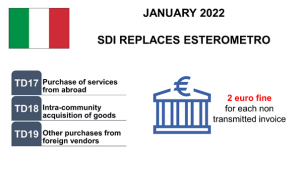Italy is going to remove the Esterometro obligation as of July 2022. Consequently, foreign transactions (including intra-community ones) will have to be reported in SdI (Sistema di Interscambio)

Background
Italy has always been considered a country with complex and demanding VAT compliance requirements. The first detailed Italian transactional reporting was called Spesometro. In that report, taxpayers were obliged to provide data about their sales and purchase invoices.
In 2019 SdI was introduced. This was one of very first real-time reporting obligations in Europe. SdI follows so-called clearance model, meaning that issued invoices needed to be pre-approved by the tax authorities (Agenzia Entrate) before they could be sent to customers. Once the SdI came into force, the Spesometro obligation was abolished.
However, export invoices were initially not covered by the SdI. Therefore, the Esterometro report was introduced. Esterometro was very similar to Spesometro, but exclusively deal with foreign invoices.
Finally, in 2021, Fattura 1.6.1. was introduced. Fattura describes the technical XML structure and the content of the invoices transmitted through SdI. The new version of Fattura contains a number of relevant fields that enable export invoice reporting. Here is a link to our detailed article about Fattura 1.6.1. (and FatturaPA 1.3.1 for B2G transactions).
Taxpayers who decided to transmit their export invoices through SdI in 2021 were already exempt from quarterly Esterometro obligations in 2021. However, as of July 2022 all taxpayers will need to submit all invoices for export through the SdI system.
Reporting of export invoices in SdI
In order to report an export invoice in Italy in SdI properly, it is required to assign the relevant document code (TipoDocumento). Sales invoices should be marked with the TD01 code, which describes the invoice and also covers supplies to non-Italian buyers (for example in case of intra-community supply of goods).
However, when it comes to purchase transactions, the method of reporting is more diverse. There are three TD codes dedicated to foreign purchase transactions: TD17 for purchase of services from abroad, TD18 for intra-community acquisition of goods, and TD19 for other purchases of goods from foreign vendors, as a result of which Italian buyers are responsible for VAT settlements.
The aforementioned codes reflect the complexity of the Italian approach to VAT reporting levied on purchase transactions from foreign suppliers. In particular, there are two special procedures that need to be followed when registering such invoices. The first one is autofatturazione, which imposes on a buyer the obligation to issue “self-invoices” for selected foreign purchases. The second one is integrazione, which simply results with reverse-charge settlement.
It is also worth mentioning that it is required to provide VAT ID of a business partner in the required VIES format if EU export invoices are being reported. The two-letter country code needs to be typed in IdPaese, whereas IdCodice should contain the remaining part of the VAT number. A simple validation of IdPaese field has been introduced. If the TD code is equal to TD17, TD18, or TD19, IdPaese cannot be filed with the IT prefix, as these document types are reserved for reporting of foreign purchases.
The deadlines for transmitting foreign transactions through SdI are as follows:
- Supplies (sales) need to be reported according to deadline for issuing the invoice, usually within 12 days of supply;
- Purchases need to be reported by the 15th day of the month after the receipt of a particular purchase invoice.
Penalties for non-compliance
Unfortunately, Italian authorities have introduced special penalties for non-compliance with the transmission of export invoices through the SdI system. Fines have been set as 2 euros for each invoice not submitted via SdI, up to 400 euros total per month.
However, if a taxpayer still sends invoices within 15 days of the deadline, the sanction can be halved to 200 euros.
Challenges in reporting export invoices in SdI
Although, the SdI system is already well-known to Italian taxpayers, the obligation to transmit data about foreign transactions may cause some challenges. The biggest issue arises from the different formats of purchase invoices that companies may receive. Suppliers need to follow their country’s requirements when it comes to the content of the invoice. What is more, each supplier usually uses a different invoice layout. Some vendors may still rely on paper invoicing.
Therefore, Italian taxpayers not only need to assign (map) required TD codes to invoices for export and generate XML; they also need to perform the required format conversions of received export invoices to the required SdI format.
Considering the above challenges and special penalties for non-compliance, it is advisable to start adapting to the upcoming obligation as soon as possible.





